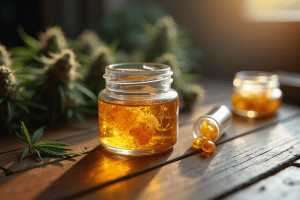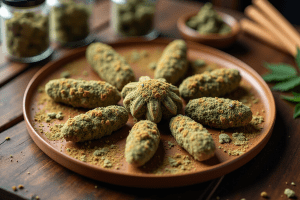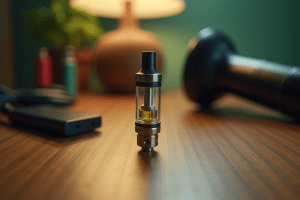Overview
This article thoughtfully compares blunts and joints, shedding light on their key differences in composition, flavor profiles, potency, and overall smoking experiences.
Have you ever wondered how these two options stack up against each other?
- Blunts, wrapped in tobacco leaves, offer a richer flavor and a more potent high, thanks to the nicotine content.
- On the other hand, joints provide a cleaner, more straightforward marijuana experience, free from the added health risks associated with tobacco.
It’s important to consider what aligns best with your preferences and health concerns. Together, let’s explore these options to make informed choices that suit your lifestyle.
Introduction
In the vibrant world of cannabis consumption, two popular methods stand out: blunts and joints. Each offers a unique experience shaped by their distinct characteristics, flavor profiles, and effects.
Have you ever wondered how these options differ?
- Blunts, wrapped in tobacco leaves, provide a richer, more complex smoking experience.
- In contrast, joints, rolled in lightweight paper, deliver a purer taste that highlights the natural flavors of the strain.
As we navigate our preferences together, understanding the nuances between these two methods becomes essential. This exploration delves into the key differences, from the potency and smoking experience to the health implications. By equipping ourselves with this knowledge, we can make informed choices on our cannabis journey.
Define Blunts and Joints: Key Characteristics
Blunts are often described as hollowed-out cigars or cigarillos filled with marijuana, typically wrapped in leaf material. This unique wrapping not only adds a distinct flavor but also introduces nicotine into the smoking experience, which can influence the overall high. In contrast, cigarettes consist entirely of ground marijuana wrapped in thin, lightweight paper that does not contain tobacco. This fundamental difference in materials significantly shapes both the smoking experience and the effects of each method.
Blunts tend to be larger and denser than rolls, allowing for a greater amount of marijuana to be contained within. This can enhance both the potency and the duration of the smoke, making blunts a favored choice among users looking for a longer-lasting session. As enthusiast ‘admindan’ notes, “Blunts, with thicker wraps, create a slower burn, resulting in a longer-lasting session.” Additionally, the inclusion of herbs in blunts may attract those who appreciate the mixed effects of marijuana and nicotine, while others might prefer rolls for their cleanliness and direct marijuana experience.
Understanding these differences is essential for consumers who wish to tailor their usage to their preferences and desired effects. Have you considered how your choices might reflect your personal preferences? Furthermore, looking at the average FTND score can provide insights into user preferences related to nicotine and tobacco use, which may influence your choice between blunts and joints. Research, such as the ACCENT study on NAC for marijuana dependence, highlights the importance of understanding various consumption methods, especially for therapeutic purposes. This broader context can empower new marijuana consumers to make informed decisions about their preferred methods of consumption, fostering a supportive and informed community.
Compare Flavor Profiles: Blunts vs. Joints
Blunts are celebrated for their rich and robust flavor profile, largely due to the leaf wrapping. This wrapping can introduce a delightful variety of flavors, such as sweet, earthy, or even spicy notes, depending on the type of leaf used. The blend of nicotine and marijuana creates an intricate taste sensation that many users find appealing. In contrast, rolled cigarettes offer a purer and simpler flavor of marijuana, allowing the natural terpenes of the strain to shine without the influence of tobacco. Many users express that joints provide a cleaner taste, making them the preferred choice for those who wish to fully enjoy the distinct characteristics of their chosen strain.
Recent consumer insights reveal an increasing preference for full gram multi-packs of pre-rolls. This trend demonstrates a longing for diversity and excellence in flavor. A case study supports this, showing that consumers favor full gram options over half-gram ones. This suggests that retailers should consider stocking products that align with these preferences. Additionally, kief-coated pre-rolls are gaining popularity, slightly edging out oil-infused options among consumers. This highlights the importance of flavor in consumer choices.
The typical cost for a pre-roll in Illinois is $17.15, which underscores the economic aspect of consumer choices in the marijuana market. Understanding how a particular plant influences taste is vital when considering blunts versus joints, as it can significantly alter the overall experience. It’s essential for consumers to reflect on their preferences when selecting between these two popular methods of consuming marijuana. Together, we can explore these choices and find what resonates best with our tastes.
Analyze Potency: Effects of Blunts and Joints
Blunts are often seen as more powerful than cigarettes, mainly due to their larger size and the addition of tobacco, which can enhance the overall high. Research indicates that blunts typically contain more cannabis than rolled cigarettes, leading to increased THC consumption per session. For instance, studies have shown that the THC levels in blunts can be significantly higher than those in regular joints, making them a popular choice for those seeking a more intense experience.
The nicotine from the wrap may contribute to a synergistic effect, enhancing the psychoactive experience. This interaction can lead to a more pronounced high, but it also raises important health concerns associated with smoking. In contrast, cannabis rolls provide a cleaner and more controlled experience, as they do not introduce nicotine or other tobacco-related compounds into the body. This distinction is crucial for users who prioritize their health and want to avoid the risks linked to smoking.
Recent studies have explored the effects of nicotine in blunts compared to rolled cigarettes, revealing that the combination of marijuana and nicotine can increase the likelihood of addiction to both substances. For example, research on ‘blunt chasing’ behavior highlights how users often smoke cigarettes or other tobacco products right after consuming blunts, complicating their relationship with both cannabis and nicotine. The Cannabis Withdrawal Scale (CWS), with a maximum withdrawal score of 190 for each subscale, underscores the potential dependence issues related to blunt and cannabis use.
Moreover, the way a blunt is rolled can significantly affect THC consumption efficiency. A well-rolled blunt allows for consistent burning, while loose or overly compressed rolls can lead to wasted smoke or difficulties in inhaling, affecting the overall enjoyment.
In conclusion, when weighing the options between blunts and joints, it’s essential to recognize that while blunts may offer a more powerful experience due to their size and nicotine content, rolled herbs present a healthier alternative for those looking to enjoy marijuana without the added risks associated with tobacco. Understanding these differences is vital for consumers navigating their choices in the cannabis landscape. As noted by Giovenco DP, “They’re Pretty Much Made for Blunts: Product Features That Facilitate Marijuana Use Among Young Adult Cigarillo Users in the United States,” the design aspects indeed cater to this consumption method. Together, we should consider balancing the various marijuana administration methods in clinical trials to provide a broader context for understanding the implications of using blunts versus joints.
Evaluate Smoking Experience: Blunt vs. Joint
Evaluate Smoking Experience: Blunt vs. Joint
The smoking experience of a blunt often invites a slower burn, allowing for longer sessions that foster a more social atmosphere. This makes blunts particularly popular in group settings, where connection is key. Many users find that the thicker tobacco wrap contributes to a smoother inhale, enhancing overall enjoyment. On the other hand, rolls tend to ignite more rapidly due to their thinner paper, leading to quicker smoking sessions that are ideal for individual use or situations where time is of the essence. Additionally, cannabis rolls frequently feature filters or supports, providing a more comfortable hold and reducing the inhalation of loose material, which can enhance the overall smoking enjoyment. Ultimately, the choice between blunt and joint hinges on personal preference, with users gravitating toward the option that best aligns with their desired experience.
Pros and Cons of Blunt vs Joint
-
Blunts:
- Pros:
- Slower burn for longer sessions, perfect for savoring moments with friends.
- A smoother inhale is achieved with a thicker wrap, highlighting the unique experience of blunts.
- Ideal for social settings, especially when discussing preferences with others.
- Cons:
- Contains tobacco, which may not appeal to everyone.
- Potential health concerns associated with their use.
- Pros:
-
Joints:
- Pros:
- Faster burn, suitable for quick sessions when you’re on the go.
- Often includes filters for a more comfortable experience.
- Generally perceived as a cleaner option, as they do not contain tobacco.
- Cons:
- Burns faster, which may not be ideal for social smoking.
- Thinner paper can lead to a harsher inhale for some users.
- Pros:
Recent trends show that both methods continue to evolve, and ongoing research highlights the need for public health campaigns to address misconceptions surrounding blunt use, particularly among high-risk populations. As Brian Beckley, Managing Editor of Marijuana Venture magazine, insightfully remarks, “Overall, it indicates that every marijuana consumer is a potential pre-roll buyer, and likely has been at some point, illustrating why the category is the fastest-growing product form in the industry, with no signs of deceleration.” As the marijuana landscape shifts, understanding these differences becomes increasingly important for consumers. Additionally, the average price for a pre-roll in Oregon is $3.87, providing valuable context for those considering their purchasing options. The need for further investigation into the health effects of blunts, especially among high-risk populations, underscores the importance of informed decision-making in the cannabis space.
Conclusion
Exploring the differences between blunts and joints can help us understand our preferences and make choices that resonate with our needs. Blunts, wrapped in tobacco leaves, provide a rich flavor and a potent experience. Their larger size and the added effects of nicotine create a unique high that many find appealing, especially in social settings where longer smoking sessions are desired. However, we must also consider the health concerns associated with tobacco, which are important to acknowledge.
In contrast, joints offer a cleaner, more straightforward cannabis experience. Their thinner paper allows the natural flavors of the strain to shine, making them a popular choice for those who prioritize flavor purity and health. The quicker burn rate of joints caters to users seeking a fast, efficient smoking experience, often enhanced with filters for added comfort.
Ultimately, the choice between blunts and joints depends on personal preference and desired effects. By understanding the nuances of each method, we can make informed decisions that align with our individual needs and health considerations. As the cannabis landscape evolves, being aware of these differences empowers us to navigate our consumption choices effectively, ensuring a more enjoyable and responsible cannabis journey together.
Frequently Asked Questions
What are blunts made of?
Blunts are typically hollowed-out cigars or cigarillos filled with marijuana and wrapped in leaf material, which adds a distinct flavor and introduces nicotine into the smoking experience.
How do blunts differ from cigarettes?
Unlike blunts, cigarettes consist entirely of ground marijuana wrapped in thin, lightweight paper that does not contain tobacco. This difference in materials significantly affects the smoking experience and effects.
What advantages do blunts have over rolls?
Blunts are larger and denser than rolls, allowing for a greater amount of marijuana to be contained, which can enhance both the potency and duration of the smoke, making them a favored choice for longer-lasting sessions.
Why do some users prefer blunts?
Users may prefer blunts for their slower burn, which results in a longer-lasting session, and for the mixed effects of marijuana and nicotine that they provide.
What are the benefits of using rolls instead of blunts?
Some users might prefer rolls for their cleanliness and a more direct marijuana experience, without the added nicotine from tobacco.
How can understanding these differences help consumers?
Understanding the differences between blunts and rolls can help consumers tailor their usage to their preferences and desired effects, allowing for more informed decisions regarding their consumption methods.
What is the significance of the average FTND score?
The average FTND score can provide insights into user preferences related to nicotine and tobacco use, which may influence the choice between blunts and joints.
Why is it important to understand various consumption methods?
Understanding different consumption methods is essential, especially for therapeutic purposes, as it empowers new marijuana consumers to make informed decisions about their preferred methods of consumption.
Get Your Medical Card
Connect with a licensed physician online in minutes












